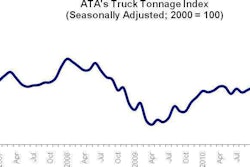P.A.M. Transportation Services Inc. on Wednesday, April 27, reported a net loss of $1.98 million for the quarter ended March 31 compared to a net loss of $315,444 for the quarter ended March 31, 2010. Operating revenues were $85 million compared to $81.8 million.
“I have very mixed emotions regarding our results from the first quarter of 2011,” said Daniel Cushman, president of the Tontitown, Ark.-based company. “On one hand, we have made great progress in key strategic areas, while on the other hand, expenses have increased and more than offset our successes during the quarter.
Cushman said on the success hand, the company increased its rate per total mile, excluding revenue from fuel surcharges, by 7.2 percent. “This increase was achieved by strategic growth with existing customers, as well as bringing on new business with better rates,” he said. “On the expense hand, we experienced many of the same increases that applied to our industry as a whole during the first quarter of 2011 – sharply escalating fuel prices, unusually harsh winter weather, increased demand and competition for qualified drivers and regulatory pressures.”
Cushman said storms during January and the first half of February suppressed utilization, causing an approximate 1.5 million reduction in miles for the first quarter of 2011 compared to the same quarter in 2010, while at the same time increasing costs such as maintenance, layovers and idle fuel consumption. “By the third week of February, the weather related disruptions in our freight lanes had diminished, and we were able to get our first look at demand for 2011, which appeared to be strong,” he said.
Cushman said the company currently is taking delivery of the first new tractors of its 450-truck purchase for 2011, with continuing purchase plans for 2012 and 2013. “The reduction in the average age of our fleet will benefit maintenance expenditures, equipment utilization, CSA compliance, and driver recruiting and retention,” he said. “However, we will go through a period of time as we transition back to a newer fleet where depreciation will be higher without receiving the full benefit of offsetting operational expense reductions.”
Cushman said that while P.A.M. lost some ground in its efforts to improve earnings year over year for the first quarter, many of its expense increases were investments necessary to position the company favorably in a market currently characterized by a decreasing capacity of qualified drivers, increased regulation and operational costs. “We continue to focus on revenue and margin improvement by adding new customers, improving freight mix, increasing our rate per mile and equipment utilization,” he said.













